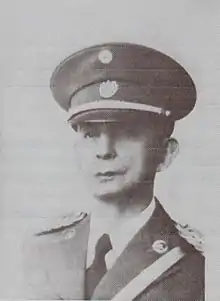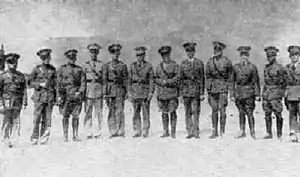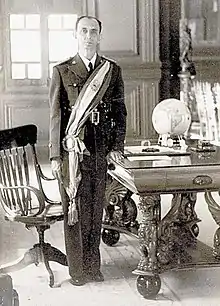Osmín Aguirre y Salinas
Osmín Aguirre y Salinas (December 25, 1889 – July 17, 1977) was President of El Salvador, from 21 October 1944 to 1 March 1945. A Colonel in the Salvadoran Army, Aguirre led two successful coups against the Salvadoran government: once in 1931 (installing General Maximiliano Hernández Martínez in power) and again in 1944 (installing himself in power). He left the power in 1945, with the assurance that his successor in the next election would be Salvador Castaneda Castro. He was later assassinated near his home in San Salvador at the age of 87.
Osmín Aguirre y Salinas | |
|---|---|
 | |
| President of El Salvador | |
| In office 21 October 1944 – 1 March 1945 Provisional President | |
| Preceded by | Andrés Ignacio Menéndez |
| Succeeded by | Salvador Castañeda |
| Chairman of the Civic Directory | |
| In office 2 December 1931 – 4 December 1931 | |
| Preceded by | Position established |
| Succeeded by | Position abolished |
| Minister of National Defense | |
| In office 2 December 1931 – 4 December 1931 Provisional Minister of National Defense | |
| Preceded by | Maximiliano Hernández Martínez |
| Succeeded by | Joaquín Valdés |
| Personal details | |
| Born | 25 December 1889 San Miguel, El Salvador |
| Died | 17 July 1977 (aged 87) San Salvador, El Salvador |
| Nationality | Salvadoran |
| Political party | Social Democratic Party |
| Military service | |
| Allegiance | |
| Branch/service | Salvadoran Army |
| Rank | Colonel |
The Supreme Court declared his term unconstitutional, even the United States did not recognize his coming to power, which deemed his regime pro-fascist.[1][2]
Personal life
Osmín Aguirre y Salinas was born in San Miguel, San Miguel, on December 24, 1889.
He married Mrs. Rosa Cardona and fathered four children.
Government of Hernández Martínez

On December 2, 1931, President Arturo Araujo was overthrown by Army officers over anger that they had not been paid.[3] Colonel Osmín Aguirre y Salinas took part in the coup and helped establish the Civic Directory.[4] The Civic Directory handed over the Presidency of El Salvador to then Vice President General Maximiliano Hernández Martínez on December 4. Aguirre y Salinas acted as Director of the National Police during Hernández Martínez's presidency from 1931 through 1944.
In January 1932, peasants across western El Salvador took up arms against the government after legislative elections were cancelled by President Hernández Martínez.[5][6] In what would become a massacre of 25,000 to 40,000 indigenous and communists,[7][8] Aguirre y Salinas was put in charge of capturing Farabundo Martí, one of the rebellion's communist leaders.
Presidency

On May 9, 1944, Maximiliano Hernández Martínez resigned due to an attempted coup, strikes being conducted against his government, and pressure from the United States.[9][10] After Hernández Martínez's resignation, Andrés Ignacio Menéndez became Provisional President of El Salvador. On October 21, 1944, Aguirre y Salinas and other military officers who previously supported Hernández Martínez overthrew Andrés Ignacio Menéndez's government and established himself as Provisional President of El Salvador.[11] He cracked down on political opposition which lead to an armed uprising being launched by students in San Salvador on December 8, followed by an insurgent attack from Guatemala four days later where dictator Jorge Ubico had been overthrown in July. Both movements were crushed by the Aguirre y Salinas government, which thus consolidated its position in power.[11]
During his brief and short presidency, he issued a decree reforming the regulations of executive power on February 28, 1945, with the purpose of making a "more rational distribution of the different branches of public administration" and considering "urgent the introduction of some reforms to the Regulation of the Executive Power, so that the incoming Government can organize said services on new bases."[12]
In January 1945, Aguirre y Salinas oversaw the presidential elections and ran in them to be elected to a second term. The election was boycotted by five candidates who withdrew after accusing Osmín Aguirre y Salinas of unfair election practices to ensure victory for his favored candidate.[13] The election ended in a victory for Salvador Castaneda Castro of the Social Democratic Unification Party with 312,754 votes and a margin of 99.70%.[14] Aguirre y Salinas himself only received 690 votes, a margin of 0.22%, in the heavily rigged election.
Osmín Aguirre y Salinas's term ended on March 1, 1945, and Salvador Castaneda Castro was sworn in as President.[11]
Later Life and Death
Osmín Aguirre y Salinas was assassinated on July 12, 1977 in San Salvador while he was being taken to the Military Hospital. He was 87 years old at the time of his death.
See also
| Political offices | ||
|---|---|---|
| Preceded by Andrés Ignacio Menéndez (provisional) |
President of El Salvador 1944–1945 (provisional) |
Succeeded by Salvador Castañeda Castro |
References
- https://www.encyclopedia.com/humanities/encyclopedias-almanacs-transcripts-and-maps/aguirre-y-salinas-osmin-1889-1977
- William P. Cochran, Jr. (February 26, 1945). "The Assistant Chief of the Division of Caribbean and Central American Affairs (Cochran) to the Ambassador in El Salvador (Simmons)".
- Grieb, Kenneth J. (1971). "The United States and the Rise of General Maximiliano Hernandez Martinez". Journal of Latin American Studies. 3 (2): 151–172. doi:10.1017/S0022216X00001425. JSTOR 156558.
- "EXMINISTROS DE DEFENSA". Ministerio de la Defensa Nacional. Retrieved September 4, 2020.
- Lungo Uclés, Mario (1996) El Salvador in the eighties: counterinsurgency and revolution Philadelphia: Temple University Press, p 114
- Nohlen, D (2005) Elections in the Americas: A data handbook, Volume I, p 277 ISBN 978-0-19-928357-6
- "Feliciano Ama, líder de la insurrección indígena de 1932". El Periódico Nuevo Enfoque (in Spanish). Archived from the original on March 18, 2007. Retrieved April 11, 2007.
- Argueta, Ricardo (April 4, 2007). "Los grandes debates en la historiografía económica de El Salvador durante el siglo XX". Boletín AFEHC (in Spanish) (29). ISSN 1954-3891.
- A Force More Powerful: A Century of Non-violent Conflict, by Peter Ackerman and Jack DuVall, St. Martin's Press, 2015, pages 256-263
- Zunes, Stephen. "Movements and Campaigns - Issues - Dictatorships - El Salvador: 1944". Archived from the original on 31 December 2010. Retrieved 4 July 2012.
- Almeida, Paul. D. (2008). Waves of Protest: Popular Struggle in El Salvador, 1925–2005. University of Minnesota Press. pp. 53–57. ISBN 9781452913520. Retrieved 13 January 2016.
- "Decrétanse Reformas al Reglamento del Poder Ejecutivo. (Decreto No 3)" (PDF). Retrieved July 26, 2020.
- Parker, Franklin D (1981) The Central American republics Westport: Greenwood Press, p152
- Nohlen, D (2005) Elections in the Americas: A data handbook Vol. 1 Oxford University Press, p287